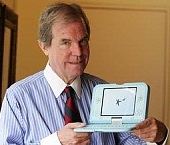While I love the technology behind the 2B1 Children's Machine, many aspects of the One Laptop Per Child project's implementation plan, or lack there of, give me pause. The main concern being the high degree of probability that massive amounts of money will be wasted without a educational boost that lives up to the hype, and the technology, not the implementation plan or execution will be blamed.
In my worry, the recent "Saying No to School Laptops" article in the Wall Street Journal hits a cord.
While I don't fall into the usual paranoia and fear mongering that says My Space is a pedophilia playground, or that every kid will be ogling porn, I do worry that without a massive educational program targeting teachers; classes will devolve into massive Instant Messaging orgies. Or as the Wall Street article says better than I:
But after school started, Ms. Adam [Abby's mother] started to worry. Abby spent class time sending instant messages to friends and wanted to create a page on social-networking site MySpace.com. Her standardized writing-test scores fell, too.Teachers need not only be comfortable with technology in their classrooms, but have a command of its use that demands respect from the students. Respect that translates into discipline and focus on schoolwork. Where is this emphasis in the OLPC leadership?So Ms. Adam handed back the computer and pulled her daughter out of the laptop program, which is this year expanding to five schools. "What she learned was how to play games and email her friends," says Ms. Adam. "School was one big happy gabfest."
Another concern I have is the hidden costs that are not talked about. $140 million before shipping of one million 2B1 Children's Machines will only be a small portion for the total implementation costs. I say less than 50% based on my technology implementation experience.

Laptops: only one cost
What might be the other $140 million in costs? Lets go back to the Wall Street Journal:
But critics say the true costs of a comprehensive laptop program -- from training staff to drafting new curriculum to installing wireless networks in schools -- are just becoming apparent. Larry Cuban, professor emeritus of education at Stanford University, says schools are balking at the array of hidden costs. "As educational dollars have grown more scarce, those extra costs give pause to more people," he says.And we're talking rich American school districts here, not impoverished local governments that often don't have enough resources to maintain decent schools and pay teachers, much less purchase basic school supplies like chalk and running water.
Also, the $140 million+ dollars spent on laptops alone will not be in addition to current school funds, it will be in lieu of other school related expenses. Thailand's Caretaker Prime Minister Thaksin Shinawatra already said that OLPC laptops will replace books.
While some may say this is a good thing, there is not objective proof, only anecdotal feel-good stories. Or as the Wall Street Journal says:
Few comprehensive studies exist on whether these programs live up to their claims to boost achievement, in part because the initiatives are so new. A preliminary study on the impact of laptops in Texas middle schools released by the Texas Center for Educational Research this spring reported that technology immersion improved student attitudes and behaviors but had a neutral impact on student achievement.Yet, the OLPC leadership is still selling a


